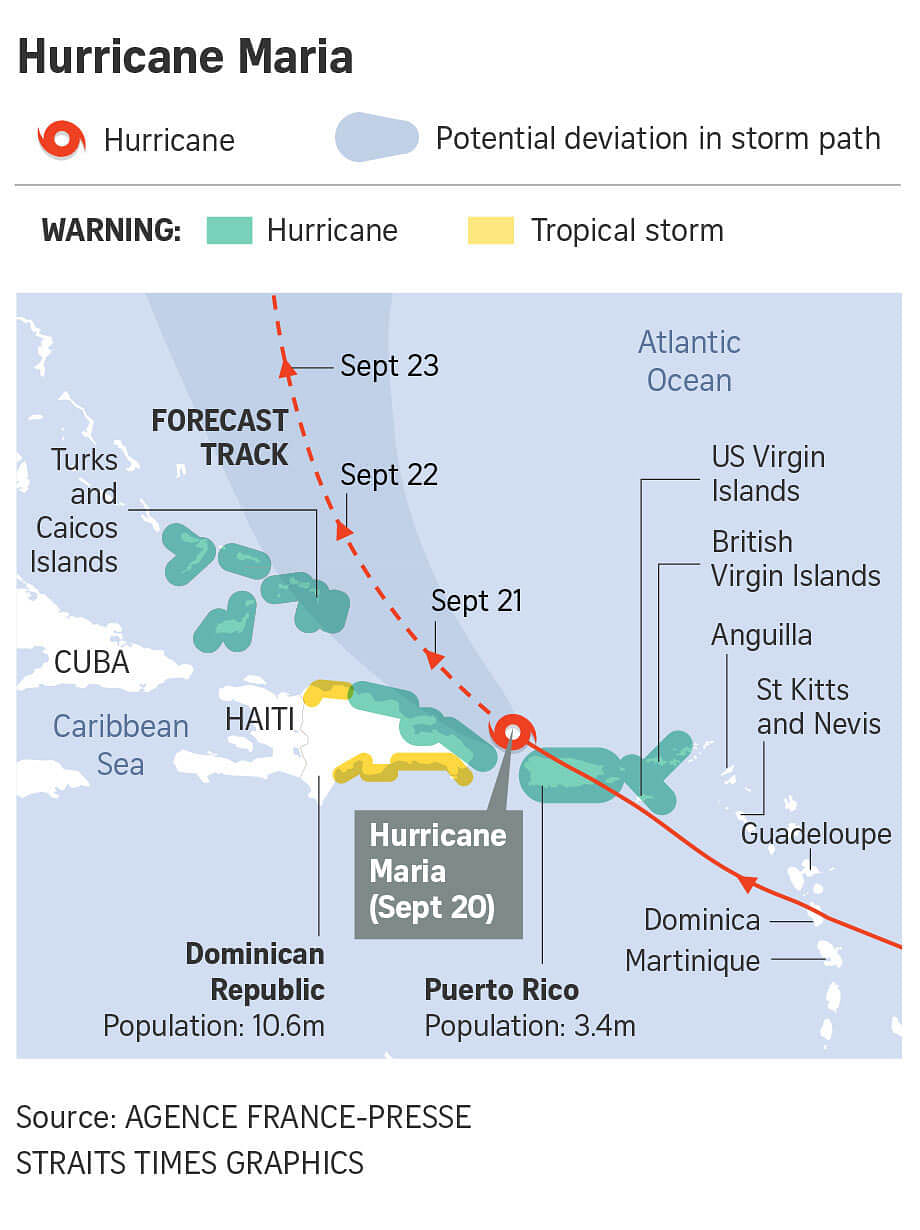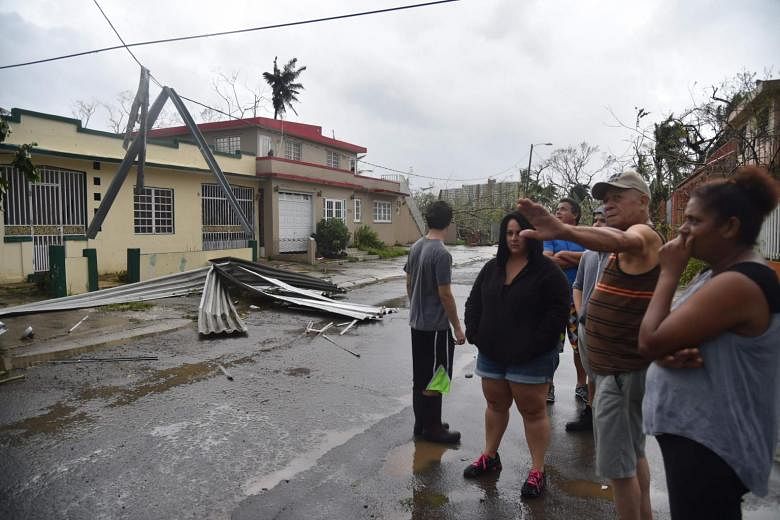SAN JUAN, Puerto Rico (NYTimes) - Hurricane Maria, the most powerful storm to make a direct hit on Puerto Rico in almost a century, ravaged the island on Wednesday (Sept 20), knocking out all electricity, deluging towns with flash floods and mudslides, and compounding the pain of residents here.
Less than two weeks ago, Hurricane Irma dealt the island a glancing blow, killing at least three people and leaving nearly 70 per cent of households without power.
Hurricane Maria, which made landfall at 6am, took out the island's entire power grid, and only added to the woes of a commonwealth that has been groaning under the weight of an extended debt and bankruptcy crisis.
Beyond the immediate damage from strong winds, continuous rain flooded coastal communities as well as neighbourhoods in the central, mountainous areas of the island, which is full of rivers and streams.
Residents woke on Wednesday to the clamour of strengthening wind gusts, with the memory of Hurricane Irma still fresh. By afternoon, the whole island had lost electricity.
"There has been nothing like this," said Ramón Lopez, a military veteran who was holding back tears outside his neighborhood in Guaynabo, on the northern coast near San Juan, the capital. "It was the fury. It didn't stop."
Such was the sentiment across the island as the barrage of howling gusts and pounding rain did not cease from the early morning until evening.
Francisco Ramirez, 23, weathered the storm inside the convenience store of a gas station in Guaynabo. As a security guard at the station, he was scheduled for the 8pm shift on Tuesday, hours before Maria hit. He sat behind a counter while the storm raged outside and water seeped in beneath the doors. Winds peeled off the aluminum roof piece by piece throughout the night, and knocked over several gas pumps.
"It felt like a tornado, as if the roof was going to come off," Ramirez said.
Thousands of residents fled the winds and rain and hunkered down in stronger buildings. More than 500 shelters have been opened in Puerto Rico, but Governor Ricardo Rosselló said he could not vouch for the storm-worthiness of those structures.
About 600 people took refuge in one of the biggest shelters, the Roberto Clemente Coliseum in San Juan. Witnesses said that the arena's roof had come off and that the shelter lacked electricity and running water.
"It's looking ugly, ugly, ugly over here," Shania Vargas, a resident of Carolina who had taken shelter in the arena, said in a telephone interview.
Mayor Carmen Yulín Cruz of San Juan remained at the shelter with residents as the hurricane struck. She told people there that there had been widespread flooding in the city, and said in a video posted to Twitter that "as uncomfortable as we are, we are better off than any other place."
Elsewhere in the capital, tree trunks and electric poles had snapped like twigs, obstructing major highways and winding mountain roads alike. If an exit was not blocked by foliage, then it was flooded. Power lines thrashed in the high winds. The commercial Roosevelt Avenue had water up to the waist.

Metal gates in affluent neighbourhoods like Caparra had been crumpled like cardboard, while makeshift trails leading to wooden houses in the barrios of Guaynabo had been made impassable by fallen trees.
Smaller towns and more rural areas, many full of wooden houses with zinc roofs, were difficult to reach after the storm, but widespread damage was reported. Mayor Félix Delgado of Cataño, on the northern coast, told a San Juan radio station that the storm had destroyed 80 per cent of the homes in the Juana Matos neighbourhood, which had been evacuated.
Photos and videos posted on social media showed severe flooding in the central areas of the island. Rivers overflowed and their waters rushed through the narrow streets, taking some homes with them.
Potable water was also affected by the storm, but the authorities could not yet say just how much damage had been done. Elí Díaz Atienza, president of the Aqueduct and Sewer Authority, said that the agency's communications systems had gone down and that he was not able to check on plants and offices.
The gates of La Plata dam in Bayamón and the Carraízo dam in Trujillo Alto, both on the northern coast, were opened to avoid flooding in the nearby areas. The authority had begun emptying the reservoirs several day ago in anticipation of heavy rain.
Rosselló said on Twitter that he had urged President Donald Trump to declare Puerto Rico a disaster zone. Trump declared an emergency in the commonwealth on Monday, and ordered federal assistance in the hurricane response. But a disaster declaration would escalate that help.
Trump called the hurricane "a big one" at a meeting in New York with King Abdullah II of Jordan. "I've never seen winds like this. Puerto Rico, you take a look at what's happening there. It's just one after another," he said.
Other islands hit by Hurricane Maria before it made landfall on Puerto Rico were still struggling to regroup.
Seven deaths had been confirmed on Dominica, where the hurricane hit Tuesday, and the toll was likely to rise, according to Hartley Henry, an adviser to Prime Minister Roosevelt Skerrit.
Housing was severely damaged and all public buildings were being used as shelters, he said.




